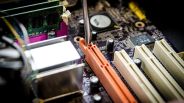NASA researchers are reaching out to the public in order to sort and identify over one million beautiful pictures taken by astronauts during missions while orbiting the Earth from the 60s until present.
Computer analysis has been a great help to NASA in their study of light pollution as well as other projects, but the computer generated results are unable to give accurate readings when the pictures are dark or ill-defined in some other manner.
NASA has compiled over 1.8 millions photos, nearly 30% of which have been taken at night. Before 2003, all night images were blurry even with the advent of high-speed film and manual tracking because the International Space Station moves at nearly 17,000 miles per hour. In 2003, the NightPod, a motorized tripod, was installed to deal with the high speeds.
"Now the pictures are clear, but their location may not be, which limits their usefulness. That's where citizen science comes in," explained a NASA press release. NASA researchers are able to ascertain where the station was at the moment the picture was snapped, but not which direction the astronaut pointed the camera.
Three crowdsourcing projects exist that the public has been asked to participate in. The first project requests assistance to distinguish between cities, stars, and other objects. The second uses night photos to identify a particular location's features. The last project simply seeks to identify the correct location on a map. Each of these projects work in tandem to make the work easier for everyone.
"Without the help of citizens, it is almost impossible to use these images scientifically. Algorithms cannot distinguish between stars, cities and other objects, such as the moon. Humans are much more efficient for complex image analysis," doctoral student at Complutense Alejandro Sanchez told CNN. And NASA isn't the first institution to reach out to citizens for help. Recently, the Smithsonian launched a huge digitization project, asking people to help transcribe historic documents. It looks like crowdsourcing is becoming a very important tool in the conventionally closed-off world of research and academia.
Visit Cities At Night for more on how you can help NASA with this special project.
ⓒ 2025 TECHTIMES.com All rights reserved. Do not reproduce without permission.




